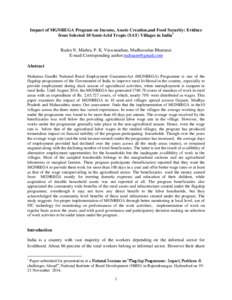Impact of MGNREGA Program on Income, Assets Creation,and Food Security: Evidence from Selected 10 Semi-Arid Tropic (SAT) Villages in India
Abstract
Mahatma Gandhi National Rural Employment GuaranteeAct (MGNREGA) Programme is one of the flagship programmes of the Government of India to improve rural livlihood in the country, especially to provide employment during slack season of agrciultural activities, when unemployment is rampant in rural India. Until August 2014, the MGNREGA has generated 1760.78 crores of mandays of work in rural areas with an expenditure of Rs. 2,65,727 croers, of which, nearly 70% were distributed as wages. This paper examines the impact of MGNREGA in 10 semi-arid villages spread acrsoss Gujarat, Madhya Pradesh and Maharashtra states. Our assessment finds that the implementation of MGNREGA in the10 villages across the three states has varied experiences. In none of the villages the average working days under the programme was found to be more than 40 days per annum. The average wage received by the beneficiaries was well below the prevailing agricultural labor wage rate in the village. However, the works under the programme generally take place in the non-agricultural season. Hence, even the wage rate is below that of the agricutlural labor wages in the studied villages, the program has produced tremendous impact on fiancial stability of the program participating households. Though over the years the average wage rate (and the total income earned) under the programme has increased, the average days of employment provided had declined over the years across all the study areas (states), or remained stagnant along with the declining number of total beneficiaries. The latter is not the result of availibility of alternative employment opportunities for the households but the inadeqaute availibility of work in the villages. Most of the sampled housheolds belongs to the marginalised sections and are agricultural laboureres or marginal farmers. These program participants (beneficiaries) reported that they want the MGNREGA to provide them work for more than 100 days in a year and offer better wage rates or at least as that of the wage ratesprevailing in the agricultural sector. The beneficiaries used the money earned from MGNREGA mostly for meeting dometic expenses and education of their children, while acquisition of durable household assets was not reported at all. The program beneficiaries also appreciated the community wide benefits of the rural assets and infrastructure created under the flagship programme, eventhough it may not have any direct benefit to the labor housheolds, but they acknowledged the communtiy level benefits of these rural infrastrures created under the program. The study suggests for proper implementation of MGNREGA through better monitoring at local level, use of ITC technilogy for monitroing on performances of the work activities, implementation of work on regular basis across the years, and with good governance and participatory decision-making on selection of work activties to be under taken under the program

